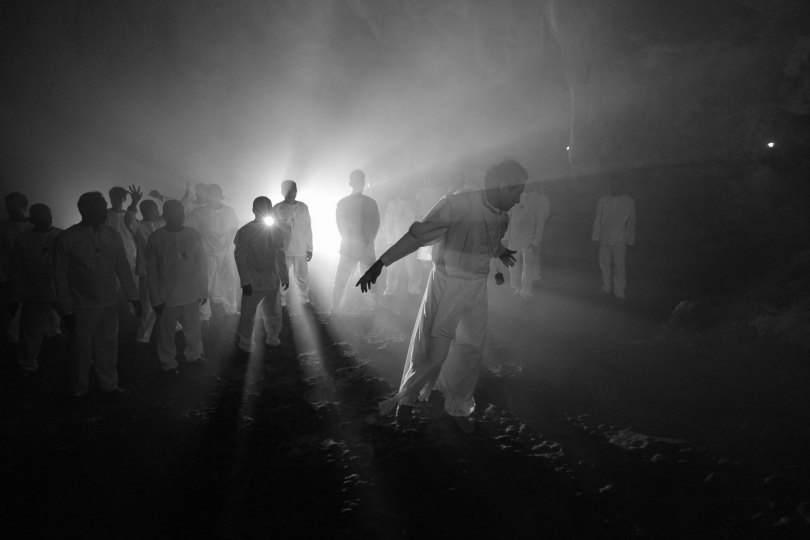Once upon a revolution

Filipino indie film titan Lav Diaz picks up a prize in Berlin for his latest eight hour opus
In a movie that perhaps reflects what’s up-most in global situation, the Golden Bear award at the just-ended Berlin International Film Festival went to a harrowing documentary dwelling on the tragic plight of migrants struggling to reach safe haven on Europe’s shores – Gianfranco Rosi’s “Fire At Sea”.
And the Berlinale’s jury members led by Meryl Streep also showed they had no hesitation in straying from the norm by giving the Alfred Bauer Prize to a film that opens a new perspective on cinematic art, the eight hour black-and-white opus by Filipino direction Lav Diaz, “A Lullaby to the Sorrowful Mystery” (“Hele sa Hiwagang Hapis”).
“Lullaby”, which due to its length, was an unusual pick for a major international festival’s competition section, thus became the first Southeast Asian film to win any award in Berlin’s main competition though Diaz, who is known for his lengthy cinematic tales, does have a host of other awards to his credit.
“My cinema is all about the struggle with time,” says Diaz of his film, which runs for a mammoth 485 minutes.
“The greatest struggle in life, in anything that we do, starts with time. We know life is continual. Everything is connected. Time for me is my obligation to cinema. That’s why I have long cuts in my film. Sometimes you don’t understand what’s happening because that is how I see time. It’s continual. It’s a mystery.”
“Lullaby”, he says is a project he’s wanted to do for the past 17 years.
“In 1999, I had a script. We were about to shoot this film but the producer cancelled it. Later I got the support of Hubert Bals Fund of International Film Festival Rotterdam and 16 years later, which was actually last year, my Filipino producer finally said ‘yes’, so we shot the film.”
Centred on the Philippine Revolution, the movement that freed the Philippines archipelago from the rule of the Spanish and a subject in which he has long been interested, “A Lullaby of the Sorrowful Mystery” begins with the execution of Dr Jose Rizal, a national hero who inspired the rebellion against the Spanish. The film introduces the audience to other characters too among them, Gregoria de Jesus, the wife of Andres Bonifacio, the father of the Father of the Philippine Revolution, who in this film, is searching for her husband’s body after the Spanish executed him in the mountains, the traitor Cesaria Belarmino, and Crisostomo Ibarra, another traitor who collaborates with the Spanish but repents after a journey in the company of Isagani, a student and poet who wanted him dead.
While some of the characters exist in history, Diaz has also borrowed the names of others from Rizal’s novel, which portrays the corruption in the Spanish Philippines. Ibarra is one of these and is the main character is Rizal’s “Noli Me Tangere”, the novel that inspired the Philippines revolution.
“I also borrowed the names Isagani and Basilio from another of his novels ‘El Filibusterismo’,” Diaz explains. “I had to make my actors understand that my process is long and takes up most of their time.”
The film saw Diaz work fir the first time with Filipino heart-throbs John Llyod Cruz and Piolo Pascual. They appear alongside veteran actors and actresses like Alessandra de Rossi, Sid Lucero, Susan Africa, Bernado Bernado and Diaz regular Hazel Orencio.
“We rehearsed a lot working from the script and I showed them the frame so that they would know how to move in the frame. I was very strict about the script but I gave them freedom in interpreting their parts. It’s just a matter of understanding their characters. They could improvise but I constantly checked that they were not getting out of their characters.”
As with most of Diaz’s films, “Lullaby” is shot in black and white and in the standard 4:3 aspect ratio.
“It’s the format of old cinema that I know and I love. I love the 4:3 ratio. I love black and white. There’s a lot of contrast and smoke in German expressionism. The birth of cinema in the Philippines is also included in this film,” he explains.
“I’d rather annoy the audience than veer from my own aesthetic. I don’t want to compromise by creating a shorter film just to create more viewers. I want them to struggle with me as a filmmaker. I want them to discover the film. If they can’t take it, that’s fine. I have no problem with that.”
Compromise, though, is sometimes necessary and for “Lullaby’s” world premiere in Berlin last Thursday, Diaz was forced to give way to the organiser’s request for a an intermission.
The film screened from 9.30am to 7pm and not unreasonably, the festival wanted a one-hour break so that viewers could enjoy lunch.
“The festival asked for the intermission. At first I asked them if the intermission could be 10 minutes, but it had to be one hour.”
After its successful screening in Berlin, the film will now travel to film festivals around the world. Diaz says he’ll soon be preparing for his next films that will be the prequel and sequel to “A Lullaby to the Sorrowful Mystery”.
“This is a trilogy actually. ‘A Lullaby to the Sorrowful Mystery’ is the middle part of the trilogy. The prequel will be about Dr Jose Rizal and Andres Bonifacio, and the sequel will be about the last years of the revolution with the young revolutionary” he says.
RELATED





